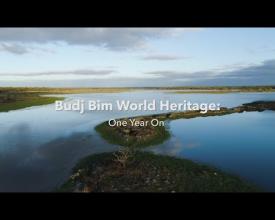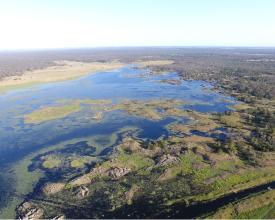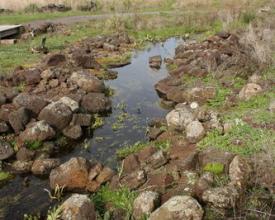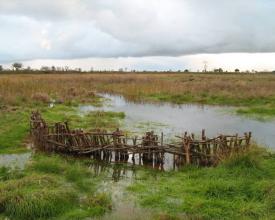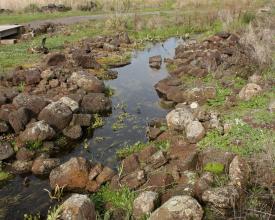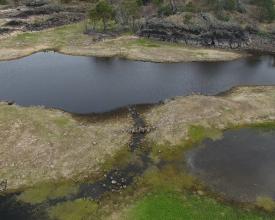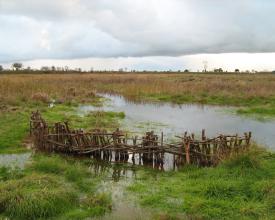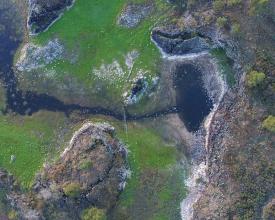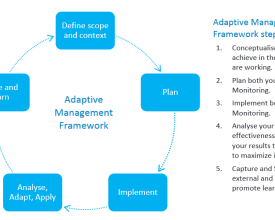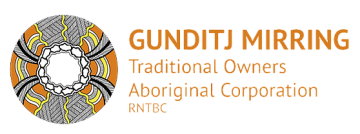
Establishing a Traditional Owner, rights-based approach for Budj Bim Cultural Landscape and ‘two-way’ knowledge management system
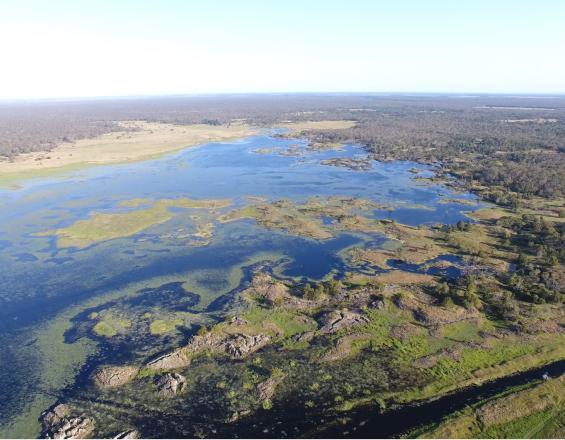
The Budj Bim Cultural Landscape lies within the Country of the Gunditjmara and is comprehensively managed and protected under a system comprising Gunditjmara customary knowledge and practices in conjunction with National and State legislation, management plans and associated policies and programs. The management system combines Traditional Owner and adaptive management approaches, in which governance and decision-making is shared.
In the early 19th century, Gunditjmara Country was occupied by British colonists and access to Country became increasingly denied to Traditional Owners until the late 20th century. The Gunditjmara retained connections to the aquaculture system through knowledge of the stories of Budj Bim and associated land-use practices. In recent years, the work of the Gunditjmara within Budj Bim has increasingly turned to the renewal and transmission of cultural traditions and practices through the access to and control of those parts of Country owned and managed by them.
Context
Challenges addressed
- Environmental challenges: The management and protection of the ecological and social wellbeing of the landscape is directly interconnected with the traditional knowledge and practices of the Gunditjmara, it is key to safeguarding ongoing connections. Additionally, climate change is potentially a key challenge for the future of Budj Bim as an eco-cultural landscape.
- Cultural and social challenges: Some loss of traditional knowledge and practices was caused by the invasion of Gunditjmara Country by British colonists. Many cultural practices have been revitalized and continued (e.g., weaving of baskets to capture eels). Ownership of the 'territory' is essential to Gunditjmara wellbeing and cultural-thriving.
- Economic challenges: Development of sustainable and manageable tourism led and implemented by Gunditjmara across the World Heritage property of Budj Bim Cultural Landscape.
Location
Process
Summary of the process
The solution recognizes the important role played by ownership in the management of Indigenous landscapes. There is the need to ensure that the ownership of the territory is in the hands of Aboriginal / Indigenous peoples and that the customary rights and obligation of traditional owners are freely exercised by Indigenous communities.
In Budj Bim, the ownership of the territory is in the hands of traditional owners and customary rights and obligations are exercised by Gunditjmara.
The care and safeguarding of the attributes and values of the Budj Bim Cultural Landscape have been enhanced through the ‘two-way’ sharing of expertise between Gunditjmara Traditional Owners and Victorian Government agencies. Additionally, Gunditjmara knowledge transmission is supported via the customary governance arrangements and via the Budj Bim Ranger Programme.
The shared and integrated protection is enforced through the established management system which is based on a framework of integrated and shared governance and an Adaptive Management Framework focused on enabling ongoing learning and adaptation by continually assessing the success of actions in meeting management objectives, and allowing for adjustment of management actions.
Building Blocks
Land ownership by the Gunditjmara Traditional Owners
Ownership is a key element for the effective protection and management of the Budj Bim Cultural Landscape. However, access to and ownership of the land was denied to Gunditjmara during great part of the 19th century when, after the arrival of British colonial invaders, Gunditjmara Country was occupied and access to the land became increasingly denied to Gunditjmara Traditional Owners until the 1980s. Nevertheless, and throughout the period of colonisation, the Gunditjmara retained connections to the aquaculture system through knowledge of the stories of Budj Bim and associated land-use practices.
From 1984, land was increasingly returned to and purchased by Gunditjmara Traditional Owners. In 2007, with the recognition of the native title rights of Gunditjmara, some parts of Country were returned to Gunditjmara. Today, Aboriginal organisations own and manage the World Heritage site of Budj Bim with the exception of Budj Bim National Park, which is co-operatively managed by the Gunditjmara Traditional Owners and the Victorian Government.
The ownership of the land enables Gunditjmara cultural traditions, knowledge and practices to be expressed in the present and into the future as a consequence of the recognition of both Gunditjmara custodial and native title rights and obligations.
Enabling factors
This building block is enabled by the recognition of the Aboriginal Land (Lake Condah and Framlingham Forest) Act 1987 (Vic.) and the determinations of the native title of the Gunditjmara in 2007 under the Native Title Act 1993 (Cwlth) and further arrangements of joint-management with the Government of Victoria.
Lesson learned
- The return of Country and the renewal of Gunditjmara knowledge and practices - concerning aquaculture in particular - have been powerful actions that have enabled Gunditjmara to continue their sense of connection, spirit and feeling of the place. As a consequence, current generations are able to grow up on Gunditjmara-owned Country, which provides a powerful mechanism for intergenerational cultural strengthening.
- Ownership of the land is a fundamental need for the management and conservation of Aboriginal and Indigenous land and landscapes and is essential to Gunditjmara wellbeing and cultural-thriving. The World Heritage property of Budj Bim is comprised of lands owned or jointly managed by the Gunditj-Mirring Traditional Owners Aboriginal Corporation and Winda-Mara Aboriginal Corporation. Therefore the site and its boundaries are assured of free, prior and informed consent by virtue of their ownership, management and control.
- Gunditjmara land ownership has demonstrated to governments that the Gunditjmara have the ability to manage their Country; and has enabled Gunditjmara to increasingly engage with the broader community.
Gunditjmara Traditional Owner customary rights and obligations
The Budj Bim Cultural Landscape is located within the traditional Country of Gunditjmara. As such, Gunditjmara have long-held rights, responsibilities and
obligations to care for Country based on continuing traditional and continuing Gunditjmara knowledge and practices.
Gunditjmara cultural traditions, knowledge and practices are evident in Gunditjmara aquaculture; as manifest in the changing practices of kooyang (eel) management, storage, harvesting and the associated manipulation, modification and management of water flows. Gunditjmara aquaculture knowledge and practices are also inclusive of sourcing grasses for the weaving of gnarraban (kooyang baskets), traditional representations of Gunditjmara aquaculture (for example, the complex designs produced on possum skin cloaks), adaptation of traditional catching techniques (for example, use of wire mesh baskets and wood crates for holding kooyang) and contemporary, creative artistic expressions of Gunditjmara aquaculture – evidenced in story-telling, dance, song, crafted objects and sculpture.
Enabling factors
The assertion of Gunditjmara rights led to their recognition by Australia’s governments from the 1980s – the Aboriginal Land (Lake Condah and Framlingham Forest) Act 1987 (Vic.) was the first legislation recognise Gunditjmara and their rights.
Gunditjmara rights are recognised under the Australian Government’s Native Title Act 1993 and the Victorian Government’s Aboriginal Heritage Act 2006. Traditional and customary rights and obligations are implemented through governance arrangements.
Lesson learned
- Ownership of the land is a key element to empower the exercise of customary and traditional rights and obligations.
- Asserting Gunditjmara identity and rights was essential in the fight to have them recognized by government.
- Within a Western colonial context, proving Gunditjmara rights and obligations to Country required engagement with research communities and technologies to ‘prove’ the existence and extend of ancestral knowledge and practices – and to have them recognized in Western terms.
Application of Continuing traditional practices through customary and recorded knowledge
The colonisation and occupation of Gunditjmara Country led to the loss of some traditional knowledge concerning the functioning of the Gunditjmara aquaculture system and particularly when access to such places was restricted because of private ownership by non-Aboriginal people. Starting from 1984, parts of the land were gradually returned to and purchased by Traditional Owners and with the return of lands to the Gunditjmara following the 2007 native title determination, the Gunditjmara’s focus turned to restoring the water flows and the revitalisation of the aquaculture system. Contemporary Gunditjmara knowledge and practices are renewed and revitalised through inherited customary knowledge. The continuation of traditional expertise (both as knowledge and practices) of Gunditjmara Traditional Owners, in combination with the protected area management expertise of government agencies, have allowed for the establishment of an enhanced adaptive management model through ‘two-way learning’. Gunditjmara customary knowledge concerning cultural water flows extends back more than 6,700 years.
Enabling factors
The continuation of traditional practices – particularly maintaining and creating channels (yereoc), weirs (from both stone and wood) and dams and modifying ponds and sinkholes – are enabled by recorded knowledge (including personal, Elder and community memories) and historical documentation. Additionally, a key element for continuing aquaculture practices has been the returned ownership of the place to Gunditjmara Traditional Owners.
Lesson learned
- Water flow – which is an attribute of the Gunditjmara aquaculture system, has been substantially returned to the Tae Rak-Killara system as a result of the Gunditjmara initiating the construction of weir on Tae Rak in 2010. This important ecological restoration, and the return of additional water to the aquaculture system, continues to enhance understanding of the system and has enabled the Gunditjmara to recollect oral and written knowledge associated with the functioning of the kooyang (eel) aquaculture network.
- The return of Country and the renewal of Gunditjmara continuing knowledge and practices concerning aquaculture have been powerful actions that have supported the Gunditjmara’s sense of spirit and feeling of the place
Budj Bim Ranger Program
Budj Bim Ranger Programme is a key component of the institutional arrangements for the management and conservation of Budj Bim eco-cultural landscape. The programme is funded by the Australian government (through it’s Indigenous Protected Areas program) and managed through the Winda-Mara Aboriginal Corporation and employs full-time rangers mentored by Gunditjmara Elders to provide them with traditional and cultural knowledge and support. The Budj Bim Rangers are responsible for the management of the Budj Bim and Tyrendarra Protected Areas. The rangers are responsible for a wide range of management activities including native flora and fauna management, building and maintaining walking tracks, providing guided tours and monitoring.
The Budj Bim rangers have a key role in ensuring the cultural continuity and the ongoing transmission of traditional and contemporary Gunditjmara knowledge and practices across generations
Enabling factors
The Indigenous Protected Areas program is funded through the Australian Government’s Indigenous Advancement Strategy program and the Budj Bim Ranger Program is implemented by the Gunditjmara in ways that support working on Country as a cultural activity that ensure transmission of knowledge and practice. Without the government funding, the Gunditjmara are not – at present – resourced to manage Country.
Lesson learned
- This management arrangement of Budj Bim Cultural Landscape allows on the ground management approaches to be guided by Gunditjmara Traditional Owners in line with cultural knowledge, traditions and practices.
- Management and conservation activities conducted by Traditional Owners through the Budj Bim Ranger Programme has led to a high-degree of control and containment of environmental weeds and pest animals; and extensive revegetation of native plant species, including Eucalypt, Acacia, Bursaria and other native trees, shrubs, sedges, groundcovers, herbs and grasses.
- The rangers are in charge of combating pest plants and animals; revegetation work using native plant species, many of cultural importance, is enhancing the natural and cultural environment.
- Rangers play a key role in outreach and educational activities through the Visiting Schools Program. The Budj Bim Rangers run this program for school groups. Approximately 50 such visits take place each year (2017).
- Land management and monitoring activities across the entire Budj Bim Cultural Landscape.
Integrated and shared governance
The customary and legislative protection of Budj Bim Cultural Landscape is enabled and implemented through an established system of governance. At the local level, the governance, decision-making and administrative bodies that oversee and cooperate in the protection and management of the place are the Budj Bim Council, the Gunditj Mirring Traditional Owners Aboriginal Corporation (GMTOAC) and the Winda-Mara Aboriginal Corporation.
- The Budj Bim Council comprises representatives of Gunditjmara Traditional Owners (the majority of Council members) and the Victorian Government. Its role is to oversee the cooperative management of the ecocultural landscape of the Budj Bim National Park to achieve both cultural and ecological objectives through joint decision-making. It demonstrates the ‘two-way’ sharing of expertise between Gunditjmara Traditional Owners and Victorian Government agencies.
- The GMTOAC manages the native title rights of the Gunditjmara and promotes continuing connection to Gundijmara Country through its Caring for Country programmes and projects. The GMTOAC owns and manages the Budj Bim Indigenous Protected Area and Lake Condah Mission.
- The Winda-Mara Aboriginal Corporation is the owner and manager of the Tyrendarra Indigenous Protected Area.
Enabling factors
This building block is enabled by the recognition of the determinations of Gunditjmara native title rights in 2007 under the Native Title Act 1993 (Cwlth) and further arrangements of joint-management with the Government of Victoria that have enabled a system of “two-way” sharing of expertise between traditional knowledge and the expertise of governmental agencies (ecology, risk management, etc). The Budj Bim Council, in particular, enables the continuous building and maintaining of relationships between Gunditjmara Traditional Owners and government.
Lesson learned
- The direct involvement of government agencies on the Budj Bim Council ensures that key stakeholders are ‘in the same room’; and that regular interaction builds trust and the capacity for ‚two-way learning’. While the Budj Bim Council formally overseas management of Budj Bim National Park, it also supports strategic planning for the broader Budj Bim landscape.
- The integrated and shared governance approach between Gunditjmara and government supports the provision of resources to care for and work on Country.
Adaptive management framework
Safeguarding the values of the Budj Bim Cultural Landscape – especially as climate changes - is based on Gunditjmara traditional knowledge and an adaptive management framework focused on enabling ongoing learning and adaptation by continually assessing the success of actions in meeting management objectives; and allowing for adjustment of management actions in the future to best achieve the management goals. Adaptive management aims to integrate specific components of management to provide a framework that systematically tests assumptions, promotes learning and continuous improvement, as well as providing timely information to support management decisions. It includes the use of monitoring, evaluation, reporting and improvement to enhance Gunditjmara learnings, implement a risk assessment approach, store and manage information, and use technology to assist in land management activities.
Lastly, this framework seeks to reinforce and encourage the connections between a healthy environment and a healthy society which are highlighted in the Gunditjmara principle of Ngootyoong Gunditj, Ngootyoong Mara (Healthy Country, Healthy People) which is closely aligned with that of Parks Victoria (Healthy Parks, Healthy People).
Enabling factors
Shared coordination and cooperation within the adaptive management framework is enabled through the shared governance and decision-making by the Gunditj Mirring Traditional Owners Aboriginal Corporation (GMTOAC), the Budj Bim Council and Winda Mara Aboriginal Corporation. The adaptive management framework is activated through protected area plans of management, the World Heritage Nomination Dossier, and the Ngootyoong Gunditj Ngootyoong Mara South West Management Plan – Stone Country.
Lesson learned
The Framework allows for ongoing learning by continually assessing the success of actions in meeting management objectives and supporting adjustment to management actions in the future. The Framework requires the integration of various elements of management to provide an approach that systematically tests assumptions, promotes
learning and continuous improvement and provides timely information to support management decisions. Ultimately, the framework seeks to reinforce and foster connections between the Gunditjmara knowledge and practices of a healthy environment and a healthy society (Ngootyoong Gunditj, Ngootyoong Mara – Healthy Country, Healthy People).
The biggest lesson learned for creating an effective adaptive management framework has been engaging with the broader local community, including neighbouring land owners. This has been achieved by going out into communities (e.g. to deliver talks) and inviting communities onto Gunditjmara land to share management perspectives.
Impacts
The solution stresses the importance of Indigenous ownership and offers a direct example of the reason why World Heritage properties whose outstanding values are associated with lands, waters and cultures of First Nations should be managed through Traditional Owner ownership and/or joint management arrangements.
- Environmental: Sustainable management of aquaculture systems and natural resources based on an adaptive management framework based on traditional and Western knowledge and practices.
- Cultural and social: Gunditjmara ownership, along with rights and obligations to Country, has seen a resurgence and flourishing of creative expression through art, craft (including weaving,possum skin cloak making), dance, song and sculpture that reinforces Gunditjmara spirituality and connection to Country. Land ownership and active management enable the Gunditjmara to continue to care for the Budj Bim Cultural Landscape. Today, Gunditjmara cultural traditions, knowledge and practices continue to be part of the six-millennia long connection with Budj Bim.
- Economic: The engineered aquaculture wetlands of the Gunditjmara have historically provided the economic basis to sustain large groups of people living in the vicinity of Tai Rak (Lake Condah). Today, Budj Bim offers an opportunity for the development of a sustainable and inclusive tourism industry that is led and managed by Gunditjmara.
Beneficiaries
The main beneficiaries are Gunditjmara Traditional Owners as well as Gundijmara Country, since Traditional Owners and Country are inextricably linked in notions of ‘Caring for Country’. Ecological and community wellbeing are deeply intertwined.
Sustainable Development Goals
Story
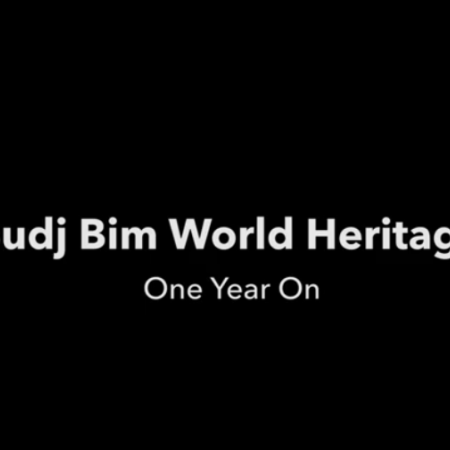
In July 2019,the Budj Bim Cultural Landscape was inscribed by the World Heritage Committee on the UNESCO World Heritage List as a series of three serial components containing one of the world’s most extensive and oldest aquaculture systems.
Budj Bim Cultural Landscape is the first place in Australia to be inscribed on the UNESCO World Heritage List purely for its Aboriginal cultural significance. The nomination was community-led and directed by the Gunditjmara Traditional Owners.
The World Heritage inscription crowned a 17-year long process of preparing the nomination, which celebrates the outstanding value of the Budj Bim Cultural Landscape and the Gunditjmara Traditional Owners.
The video "Budj Bim - One Year On" (https://www.youtube.com/watch?v=DtPOzOWa4Xs) looks at the path to World Heritage, one year after inscription and the impact of global challenges.

